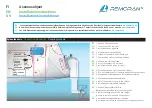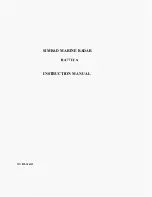
APPENDIX 3 DIGITAL INTERFACE
AP-14
OSD - Own ship data
RSD - Radar system data
TLB - Target label
TTD - Tracked target data
$**OSD,53.21,A,57.89,R,12.52,R,45.67,6.78,N*hh<CR><LF>
1 2 3 4 5 6 7 8 9
1. Heading, degrees true (0.00 - 359.99, null)
2. Heading status (A=data valid, V=data invalid)
3. Vessel course, degrees true (0.00 - 359.99, null)
4. Course reference (B/M/W/R/P, null)
B=Bottom tracking log
M=Manually entered
W=Water
referenced
R=Radar tracking (of fixed target)
P=Positioning system ground reference
5. Vessel speed (0.00 - 999.99, null)
6. Speed reference, B/M/W/R/P
7. Vessel set, degrees true, manually entered (0.00 - 359.99)
8. Vessel drift (speed), manually entered (0.00 - 99.99, null)
9. Speed units (N=Knots)
$RARSD,x.x,x.x,x.x,x.x,x.x,x.x,x.x,x.x,x.x,x.x,x.x,N,H*hh <CR><LF>
1 2 3 4 5 6 7 8 9 10 11 12 13
1. Origin 1 range, from own ship (0.000 - 999) (see note 2)
2. Origin 1 bearing, degrees from 0 (0.0 - 359.9) (see note 2)
3. Variable range marker 1(VRM1), range (0.000 - 999)
4. Bearing line 1(EBL1), degrees from 0 (0.0 - 359.9)
5. Origin 2 range (0.000 - 999.9) (see note 2)
6. Origin 2 bearing (0.0 - 359.9)(see note 2)
7. VRM2,.9 range (0.000 - 999)
8. EBL2, degrees (0.0 - 360.0)
9. Cursor range, from own ship (0.000 - 999)
10. Cursor bearing, degrees clockwise from 0 (0.0 - 359.9)
11. Range scale in use (0.0625 - 120)
12. Range units (K/N/S)
13. Display rotation (see note 1)
NOTES
1 Display rotation:
C=Course-up, course-over-ground up, degrees true
H=Head-up, ship's heading(center-line) 0 up
N=North-up, true north is 0 up
2 Origin 1 and origin 2 are located at the stated range and bearing from own ship and provide for two
independent sets of variable range markers (VRM) and electronic bearing lines (EBL) originating
away from own ship position
.
$**TLB,x.x,c--c,x.x,c--c,…,x.x,c--c*hh<CR><LF>
1 2 3 3
1. Target number “n” reported by the device (1 - 1023)
2. Label assigned to target “n” (TT=00 - 99, AIS=000000000 - 999999999)
3. Additional label pairs
!**TTD,xx,xx,x,s--s,x*hh<CR><LF>
1 2 3 4 5
1. Total hex number of sentences need to transfer the message (1 - FF)
2. Hex sentence number (1 - FF)
3. Sequential message identifier (0 - 9)
4. Encapsulated trancked target data (6 bit binary-converted data)
5. Number of fill bits (0 - 5)
Summary of Contents for FAR-3230SW-BB
Page 14: ...EQUIPMENT LIST xii This page is intentionally left blank ...
Page 36: ...1 INSTALLATION 1 22 This page is intentionally left blank ...
Page 112: ...3 SETTINGS AND ADJUSTMENTS 3 12 This page is intentionally left blank ...
Page 142: ...D 1 12 Sep 2014 H MAKI ...
Page 143: ...D 2 12 Sep 2014 H MAKI ...
Page 144: ...20 Jan 2014 H MAKI D 3 ...
Page 145: ...4 Jul 2014 H MAKI D 4 ...
Page 146: ...2 Nov 2012 Y NISHIYAMA D 5 ...
Page 147: ...13 Feb 2014 H MAKI D 6 ...
Page 148: ...24 Mar 2014 H MAKI D 7 ...
Page 149: ...24 Mar 2014 H MAKI D 8 ...
Page 150: ...18 Jan 2014 H MAKI D 9 ...
Page 151: ...18 Jan 2014 H MAKI D 10 ...
Page 152: ...18 Jan 2014 H MAKI D 11 ...
Page 153: ...7 Nov 2012 Y NISHIYAMA D 12 ...
Page 154: ...7 Nov 2012 Y NISHIYAMA D 13 ...
Page 155: ...7 Nov 2012 Y NISHIYAMA D 14 ...
Page 156: ...D 15 24 May 2012 Y NISHIYAMA ...
Page 157: ...D 16 24 May 2012 Y NISHIYAMA ...
Page 158: ...D 17 24 May 2012 Y NISHIYAMA ...
Page 159: ...7 Nov 2012 Y NISHIYAMA D 18 ...
Page 160: ...7 Nov 2012 Y NISHIYAMA D 19 ...
Page 161: ...7 Nov 2012 Y NISHIYAMA D 20 ...
Page 162: ...Apr 05 04 D 21 ...
Page 163: ...7 Nov 2012 Y NISHIYAMA D 22 ...
Page 164: ...D 23 13 Jan 2012 Y NISHIYAMA ...
Page 165: ...D 24 13 Jan 2012 Y NISHIYAMA ...
Page 166: ...D 25 13 Jan 2012 Y NISHIYAMA ...
Page 167: ...D 26 13 Jan 2012 Y NISHIYAMA ...
















































